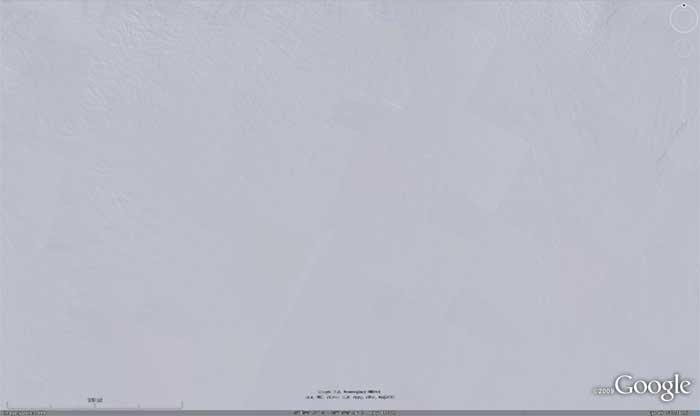|
|
|
|
HalfMooner
Dingaling

Philippines
15831 Posts |
 Posted - 10/01/2009 : 11:52:43 Posted - 10/01/2009 : 11:52:43



|
What on Earth? # 84: Hidden Murder Suspect
Well, maybe we better call it an "object of interest," rather than a suspect.
But there it is, right there: The possible-maybe unindicted murderer of the majority of terrestrial species and almost all marine species.
Maybe.
For one point per question:
1. Where is this?
2. What may lay in hiding there?
3. Assuming it's what some people suspect it is, and assuming it did what they think it might have done, then when did it do it, and what's the scientific name for what it did?

Click for larger version
|
“Biology is just physics that has begun to smell bad.” —HalfMooner
Here's a link to Moonscape News, and one to its Archive. |
Edited by - HalfMooner on 10/01/2009 21:10:30
|
|
|
Hal
Skeptic Friend

USA
302 Posts |
Posted - 10/01/2009 : 12:52:24 [Permalink]



|
| OK, this one's just a wild guess. Is this the Wilkes Land ice cap, which covers an area known as the Wilkes Land mass concentration anomaly? Some believe this to indicate the existence of one or more pre-historic impact craters, which are further speculated to have been a cause of the Permian-Triassic extinction event, 250 million years ago (give or take a few million years). |
Nothing in all the world is more dangerous than sincere ignorance and conscientious stupidity.
Martin Luther King Jr.
 |
 |
|
|
HalfMooner
Dingaling

Philippines
15831 Posts |
 Posted - 10/01/2009 : 21:39:58 [Permalink] Posted - 10/01/2009 : 21:39:58 [Permalink]



|
Originally posted by Hal
OK, this one's just a wild guess. Is this the Wilkes Land ice cap, which covers an area known as the Wilkes Land mass concentration anomaly? Some believe this to indicate the existence of one or more pre-historic impact craters, which are further speculated to have been a cause of the Permian-Triassic extinction event, 250 million years ago (give or take a few million years).
|
That "wild guess" is correct, Hal. Three more points for you!
You answered this just as I was correcting bad grammar in the second question. At least I got a chance to rest for a few hours.

Wilkes Land "Crater" (from Wikipedia)
Yes, what is known about the (possible) "Wilkes Land crater" is this: There is a "a 300 km (200 mi) wide" "mascon" at 70°S 120°E. The gravity anomaly was detected by NASA's GRACE satellites. Also, radar has detected what may be the ring walls of a "480 km (300 mi) wide impact crater" around the mascon.
Nobody's yet drilled through the thick ice to see what's really there, so everything is highly speculative still.
As Wiki states it:The Wilkes Land mass concentration (or mascon) is centered at 70°S 120° and was first reported at a conference in May 2006 by a team of researchers led by Ralph von Frese and Laramie Potts of Ohio State University. The team used gravity measurements by NASA's GRACE satellites to identify a 300 km (200 mi) wide mass concentration and noted that this mass anomaly is centered within a larger ring-like structure visible in radar images of the land surface beneath the Antarctic ice cap. This combination suggested to them that the feature may mark the site of a 480 km (300 mi) wide impact crater buried beneath the ice.
Due to the site's location beneath the Antarctic ice sheet there are no direct samples to test for evidence of impact. There are alternative explanations for this mass concentration, such as formation by a mantle plume or other large-scale volcanic activity [citation needed]. If this feature really is an impact crater, then, based on the size of the ring structure, it has been suggested by von Frese's team that the impactor could have been four or five times wider than the one that created the Chicxulub Crater, believed to have caused the Cretaceous-Tertiary extinction event.
Because mass concentrations on Earth are expected to dissipate over time, von Frese and coworkers believe the structure must be less than 500 million years old, and also note that it appears to have been disturbed by the rift valley that formed 100 million years ago during the separation of Australia from the Gondwana supercontinent. These researchers therefore speculate that it is possible that the putative impact and associated crater contributed to this separation by weakening the crust at this location. These bracketing dates also make it possible that the site could be associated with the Permian-Triassic extinction event.
[Emphasis added.] |
The standings:- Hal, 31 points
- steinhenge, 24 points
- Dave W., 8 points
- bngbuck, 7 points
- Hawks, 5.5 points
- lorddix, 4 points
- Randy, 3 points
- R.Wreck, 3 points
- sailinsoul, 3 points
- Simon, 2 points
(Ties are listed in alphabetical order.)
|
“Biology is just physics that has begun to smell bad.” —HalfMooner
Here's a link to Moonscape News, and one to its Archive. |
| Edited by - HalfMooner on 10/01/2009 22:15:22 |
 |
|
|
 |
|
|
|
![]()